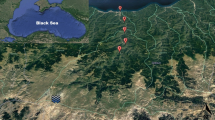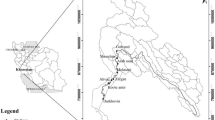Abstract
The need to constantly monitor water quality is paramount as water pollution increases exponentially. In our study, data published by King County, Washington, USA, has been used to compare the performance of several algorithms which were used in predicting water quality index (WQI) and classifying water quality classification (WQC). Multilayer perceptron (MLP) performs most efficiently in both tasks with an RMSE of 0.76, R2 of 0.99, and classification accuracy of 97.1%. Feature analysis shows that phosphorus and ammonia nitrogen have considerable influence on predicting WQC and WQI, respectively, even though they were not directly used in the calculation of WQI. Sensitivity analysis done on the MLP model further shows that after removing the most important feature of turbidity as an input parameter, the model had an RMSE of 12.86 and an R2 of 0.84, respectively. It can be considered as one of the most significant parameters since it affects the WQI drastically.
Access this chapter
Tax calculation will be finalised at checkout
Purchases are for personal use only
Similar content being viewed by others
References
Rahmanian, N., Ali, S.H.B., Homayoonfard, M., Ali, N.J., Rehan, M., Sadef, Y., Nizami, A.S.: Analysis of physicochemical parameters to evaluate the drinking water quality in the state of Perak, Malaysia. J. Chem. 2015, Article ID 716125, 10 pages, (2015). https://doi.org/10.1155/2015/716125
Fadiran, A.O., Dlamini, S.C., Mavuso, A.: A comparative study of the phosphate levels in some surface and ground water bodies of Swaziland. Bull. Chem. Soc. Ethiop. 22 (2008). https://doi.org/10.4314/bcse.v22i2.61286
Employee Security Department, KingCounty Profile, https://esd.wa.gov/labormarketinfo/county-profiles/king. Last accessed 2021/10/29
Seattletimes, seattle-news, https://www.seattletimes.com/seattle-news/king-county-cites-soaring-costs-climate-change-in-bid-to-redo-water-pollution-agreement-with-state-and-feds/. Last accessed 2021/10/26
Environmentalprotectionagency, newsreleases, https://www.epa.gov/newsreleases/epa-announces-96-million-wifia-loan-king-county-washington-improve-water-quality-puget. Last accessed 2021/10/26
Khan, Y., See, C.S.: Predicting and analyzing water quality using machine learning: a comprehensive model. In: 2016 IEEE Long Island Systems, Applications and Technology Conference (LISAT), pp. 1–6 (2016). https://doi.org/10.1109/LISAT.2016.7494106
Haghiabi, A.H., Nasrolahi, A.H., Parsaie, A.: Water quality prediction using machine learning methods. Water Qual. Res. J. 53(1): 3–13 (2018). https://doi.org/10.2166/wqrj.2018.025
Aldhyani, T.H.H., Al-Yaari, M., Alkahtani, H., Maashi, M.: Water quality prediction using artificial intelligence algorithms. Appl. Bionics Biomech. 2020, Article ID 6659314, 12 pages (2020). https://doi.org/10.1155/2020/6659314
Samsudin, M.S., Azid, A., Khalit, S.I., Sani, M.S.A., Lananan, F.: Comparison of prediction model using spatial discriminant analysis for marine water quality index in mangrove estuarine zones. Marine Pollut. Bull. 141, 472–481 (2019). ISSN 0025-326X, https://doi.org/10.1016/j.marpolbul.2019.02.045
Devi, S.V.S.G.: Random forest advice for water quality prediction in the regions of Kadapa district. Int. J. Innov. Technol. Explor. Eng. 8, 1–3 (2019)
Victoriano, J.M., Lacatan, L.L., Vinluan, A.A.: Predicting river pollution using random forest decision tree with GIS model: a case study of MMORS, Philippines. Int. J. Environ. Sci. Dev. 11(1), 36–42 (2020)
Nouraki, A., Alavi, M., Golabi, M., et al.: Prediction of water quality parameters using machine learning models: a case study of the Karun River. Iran. Environ. Sci. Pollut. Res. 28, 57060–57072 (2021). https://doi.org/10.1007/s11356-021-14560-8
Faridah Othman, M.E., Alaaeldin, M.S., Ahmed, A.N., Teo, F.Y., Fai, C.M., Afan, H.A., Sherif, M., Sefelnasr, A., El-Shafie, A.: Efficient river water quality index prediction considering minimal number of inputs variables. Eng. Appl. Comput. Fluid Mech. 14(1), 751–763 (2020). https://doi.org/10.1080/19942060.2020.1760942
Keiser, D.A., Kling, C.L., Shapiro, J.S.: The low but uncertain measured benefits of US water quality policy. Proc. Natl. Acad. Sci. 116(12) 5262–5269 (2019). https://doi.org/10.1073/pnas.1802870115
Ahmed, U., Mumtaz, R., Anwar, H., Shah, A.A., Irfan, R., García-Nieto, J.: Efficient water quality prediction using supervised machine learning. Water 11(11), 2210 (2019). https://doi.org/10.3390/w11112210
Shakya, S., Pulchowk, L.N., Smys, S.: Anomalies detection in fog computing architectures using deep learning. J. Trends Comput. Sci. Smart Technol. no. 1, 46–55 (2020)
Thudumu, S., Branch, P., Jin, J., et al.: A comprehensive survey of anomaly detection techniques for high dimensional big data. J. Big Data 7, 42 (2020). https://doi.org/10.1186/s40537-020-00320-x
Ji, Z., Gong, J., Feng, J.: A novel deep learning approach for anomaly detection of time series data. Sci. Programm. 2021, Article ID 6636270, 11 pages (2021). https://doi.org/10.1155/2021/6636270
Cho, K.H., Han, D., Park, Y., Lee, S.W., Cha, S.M., Kang, J.H., Kim, J.H.: Evaluation of the relationship between two different methods for enumeration fecal indicator bacteria: colony-forming unit and most probable number. J. Environ. Sci. (China) 22, 846–850 (2010). https://doi.org/10.1016/s1001-0742(09)60187-x. PMID: 20923095
Ali, J., Khan, R., Ahmad, N., Maqsood, I.: Random forests and decision trees. Int. J. Comput. Sci. Issues (IJCSI) (2012)
Popescu, M., Balas, V., Perescu-Popescu, L., Mastorakis, N.: Multilayer perceptron and neural networks. WSEAS Trans. Circ. Syst. 8 (2009)
Rana, A., Singh Rawat, A., Bijalwan, A., Bahuguna, H.: Application of multi layer (perceptron) artificial neural network in the diagnosis system: a systematic review. In: 2018 International Conference on Research in Intelligent and Computing in Engineering (RICE), pp. 1–6 (2018). https://doi.org/10.1109/RICE.2018.8509069
Chen, T., Guestrin, C.: XGBoost: A scalable tree boosting system. In: Proceedings of the 22nd ACM SIGKDD International Conference on Knowledge Discovery and Data Mining (KDD ‘16). Association for Computing Machinery, New York, NY, USA, pp. 785–794 (2016). https://doi.org/10.1145/2939672.2939785
Tu Tu, C., Liu, H., Xu, B.: AdaBoost typical Algorithm and its application research. In: MATEC Web of Conferences, 139, 00222 (2017) https://doi.org/10.1051/matecconf/201713900222
Sarker, I.H.: Machine learning: algorithms, real-world applications and research directions. SN Comput. Sci. 2, 160 (2021). https://doi.org/10.1007/s42979-021-00592-x
John, G.H., Langley, P.: Estimating continuous distributions in bayesian classifiers. In: Proceedings of the Eleventh conference on Uncertainty in artificial intelligence, Morgan Kaufmann Publishers Inc. pp. 338–345 (1995)
Mahesh, B.: Machine Learning Algorithms—A Review (2019). https://doi.org/10.21275/ART20203995
Idris, A., Mamun, A.A., Soom, M., Sulaiman, W.: Review of water quality standards and practices in Malaysia 22, 145–155 (2003)
Silveira, M.L., Joao, M.B., Vendramini, Sollenberger, L.E.: Phosphorus management and water quality problems in grazingland ecosystems. Int. J. Agronomy, Article ID 517603, 8 pages (2010). https://doi.org/10.1155/2010/517603
Calmuc, V.-A., Calmuc, M., Țopa, C., Mihaela, T., Iticescu, C., Georgescu, L.: Various methods for calculating the water quality index 41, 171–178 (2018). https://doi.org/10.35219/ann-ugal-math-phys-mec.2018.2.09.
Healthy Environments, oregon.gov https://www.oregon.gov/oha/ph/HealthyEnvironments/DrinkingWater/Monitoring/Documents/health/ammonia.pdf. Last accessed 2021/12/22
Dissolved_oxygen,enr.gov, https://www.enr.gov.nt.ca/sites/enr/files/dissolved_oxygen.pdf. Last accessed 2021/12/22
Water quality criteria, epa.gov, https://www.epa.gov/sites/default/files/2015-10/documents/rwqc2012.pdf. Last accessed 2021/12/22
Author information
Authors and Affiliations
Corresponding author
Editor information
Editors and Affiliations
Rights and permissions
Copyright information
© 2022 The Author(s), under exclusive license to Springer Nature Singapore Pte Ltd.
About this paper
Cite this paper
Mittra, A., Singh, D., Banda, A. (2022). A Supervised Machine Learning Approach for Analysis and Prediction of Water Quality. In: Shakya, S., Ntalianis, K., Kamel, K.A. (eds) Mobile Computing and Sustainable Informatics. Lecture Notes on Data Engineering and Communications Technologies, vol 126. Springer, Singapore. https://doi.org/10.1007/978-981-19-2069-1_18
Download citation
DOI: https://doi.org/10.1007/978-981-19-2069-1_18
Published:
Publisher Name: Springer, Singapore
Print ISBN: 978-981-19-2068-4
Online ISBN: 978-981-19-2069-1
eBook Packages: Intelligent Technologies and RoboticsIntelligent Technologies and Robotics (R0)




